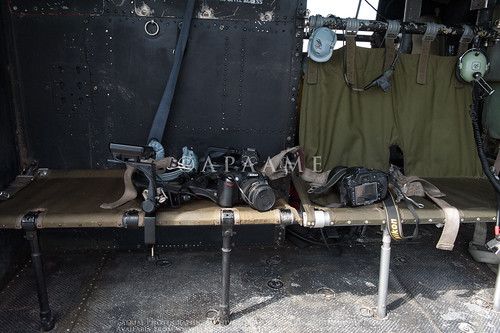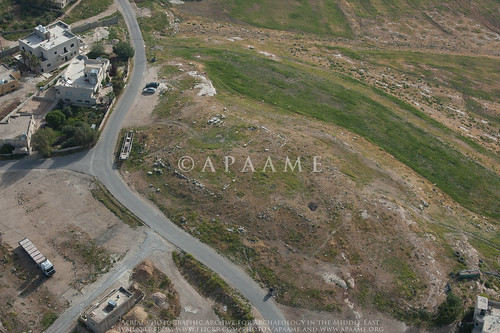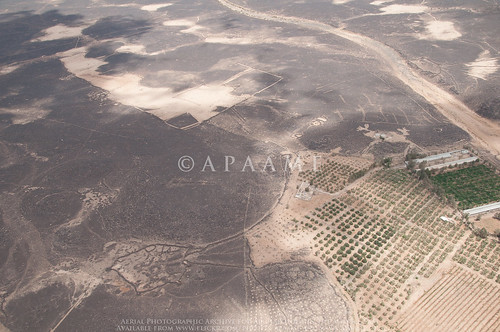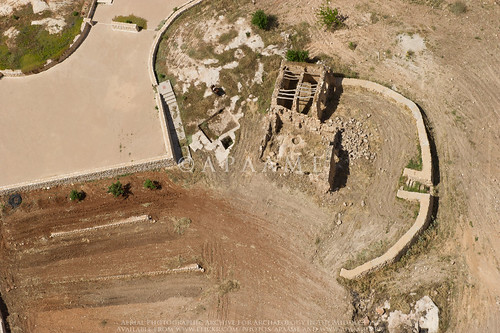You may remember earlier this year we conducted an aerial photography workshop at the new UCL Qatar campus with Włodzimierz 'Wlodek' Rączkowski (see DLK's blog here). Wlodek has been kind enough to contribute the following comments, which have now found their way to our blog.
A White Easter! No, that's not a mistake – if you had spent Easter in Poland this year you too would have thought a Christmas tree more suitable and looked for Santa rather than the first spring flowers and chocolate eggs. So this Easter-winter lead me to think about my visit to Qatar back in February. The flowers were blooming and the weather conditions were much more spring-like. A different world altogether.
Why Qatar? It came as quite a surprise. Bob Bewley (UK) and David Kennedy (Australia) together with Lisa Usman from UCL Qatar undertook the initiative to organise a “short course” on aerial archaeology (10-14 February). An exotic subject in an exotic country and I got to go along by chance as a tutor/lecturer. You can read more about the workshops themselves in AARGnews vol. 46 (March 2013), p. 15-18 –
The AARG website can be found HERE.
Everything in Qatar was amazing, new, different, unexpected – including the workshop timetable. Is it possible to fit in a bit of rest and relaxation and sightseeing halfway through a series of workshops? Actually yes, it is – for it turned out that Tuesday (12th February) was National Sport Day, a surprise for both the organisers and lecturers. A double surprise in fact – a day of sporting events at a national level (less surprising when you recall that Qatar is due to hold the Football World Cup in 2022 and when you spot the joggers in all their gear along Doha's Corniche or main boulevard) and a public holiday so that everyone can “do a bit of sport”. Well, how to make the most of such a gift?
Qatar isn't a large country but then not all the sights to see are located in Doha. I persuaded Bob and David to take a trip south to Khor Al-Adaid, also known as the “Inland Sea”. It's a large tidal inlet with a convoluted shoreline cutting deeply into the land dividing Qatar from Saudi Arabia. It is connected to the Gulf by a deep, narrow channel. There is no comparable lagoon system of this type known anywhere else in the world. It is a UNESCO nature reserve (see: http://whc.unesco.org/en/tentativelists/5317/ ). A large system of barchans and parabolic dunes covers flat areas of former marine sediments creating a unique landscape. For those of us from the northern hemisphere (Bob and myself), the yellow sand, turquoise water and blue sky set the perfect scene for a bit of relaxation.
The Inland Sea is not particularly easy to get to. There are no roads leading to it but kilometres of sand dunes to cross. The only option was to hire a car and Bob, after having made a number of phone calls, managed to acquire a 4WD Nissan XTERRA – the best choice of vehicle for a trip across Qatar; ideal that is if one has all the additional equipment (spade, ropes, lots of water) and experience of driving over dunes. It turned out that we had the car... and nothing but the car.
As we approached Masaieed (only about 40 km from Doha) the first impressive dunes could be seen. After that there were no roads or signs to follow, only a general direction of SSW and the tyre tracks of other cars to indicate where we should be going. So when the tracks forked off into two directions, what were we to do? Was this our intended destination? There we were, driving “in the dark” at high noon in a land flooded in sunlight and sand. It was quite busy near Masaieed as there were many places to hire quad-bikes and go scrambling over the dunes. The further S we went, the more deserted it got: fewer people, cars, signs of civilisation. We encountered the odd car or two sporadically (did they know the way better than us? - not too unreasonable an assumption).
After about 2 hours driving, without great misadventure, we made it to our destination – the Inland Sea. Good job we didn't decide to drive up to the waterline (though it was rather tempting) – the sand was really slushy and it was hard to get up to the water's edge even on foot.
And what do Europeans do when they find themselves by the sea, surrounded by sand and blue skies overhead? That's right, they head out for a paddle – and... what a disappointment that was. The temperature of the water was more like the Baltic in the summer (about 17-18 degrees). Brrrrrr! Just a quick dip then.
The suggestion to climb up the nearest dune was outvoted 2:1, so it was time to get ready to head back. One question which arose quite quickly was: do we have enough fuel? Apart from this one concern the journey back went smoothly – up to a point. At 14:02:15 (according to our SatNav) we got stuck in a dune which caught us unawares for this dune was nothing special, just a bit of loose sand. We'd managed to scale much larger dunes before! It turns out that “reading this sandy landscape” is in fact quite an important skill.
So what now – it's no use having a great 4WD drive if you don't have either a spade or ropes. A couple of attempts to move forward/back and... we were chassis-deep in the sand. A few cars drove past but not one stopped, hardly surprising as they were probably tourists. Fortunately for us a “local” spotted us and realising that we were in trouble he offered to help. The first manoeuvres (reversing, letting some air out of the tyres) were unsuccessful. Time for the rope. Luckily, our local hero did have one and easily towed us out of the sand trap. The rest of the journey was uneventful, we did have enough fuel. We had all been so intent on getting out of the sand that not one of us thought to take a photo (photography specialists that we are!).
 |
| Extensive stone structures in the shallows near Abu Dhulouf. |
And so back to the photography then. When I was travelling around Qatar I thought about the usefulness of aerial photographs in this country, especially in documenting archaeological heritage. I did not see too many opportunities. At least not until after the workshops when I went north to the area around Abu Dhulouf. It was low tide, so there was no chance of swimming but it was possible to go wading ankle-deep in water across the sandy expanse. I observed extensive stones structures – low walls stretching for kilometres. It was impossible to capture their spatial structure. I imagine they were fish-traps, or perhaps an area for hunting birds. I have no doubt that aerial photographs would be the perfect method for documentation and mapping. Shortly after take-off from Doha I noticed a similar though smaller stone structure. There's my reason to return!







.jpg)










































